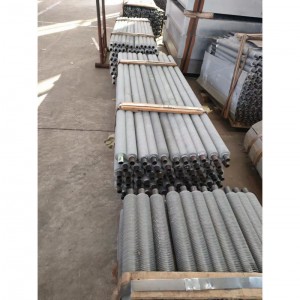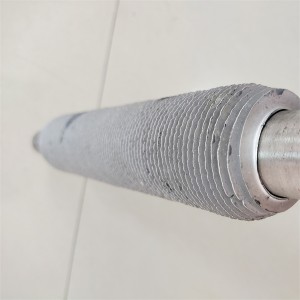Bimetallic Extruded Finned Tube
Bimetallic Extruded Finned Tube
1. Material
Bimetallic extruded finned tubes combine two metals:
Base Tube: Typically carbon steel (e.g., 20, Q235), stainless steel (304, 316L), or copper/copper alloys to ensure structural strength and pressure resistance.
Fins: Aluminum or aluminum alloys (e.g., 1050, 6063) extruded onto the base tube surface, leveraging lightweight, high thermal conductivity, and corrosion resistance.
2. Dimensional Specifications
Base Tube OD: 15–50 mm (customizable from 10–150 mm for special needs).
Fin Height: 8–25 mm (adjustable density).
Fin Thickness: 0.3–2.0 mm (typical for aluminum fins).
Fin Spacing: 3–12 mm (supports sparse or dense layouts).
Tube Length: 1–12 m (continuous extrusion allows ultralong tubes).
3. Features
Bimetallic Bonding: Aluminum fins are metallurgically bonded to the base tube via mechanical extrusion, eliminating welds and enhancing peel resistance.
Corrosion Resistance: The aluminum layer protects the base tube from oxidation, moisture, and chemical corrosion.
Lightweight: 30–50% lighter than allsteel finned tubes.
Broad Temperature Range: Operates from 50°C to 350°C, suitable for most industrial environments.
4. Advantages
High Thermal Efficiency: Combines aluminum’s conductivity with increased surface area for superior heat transfer.
CostEffective: Uses expensive metals (e.g., stainless steel) only in critical areas, reducing overall costs.
Low Maintenance: Resists fouling and corrosion, minimizing downtime for cleaning.
Design Flexibility: Supports multiple material combinations (e.g., copper base + aluminum fins).
5. Applications
HVAC Systems: Air coolers, condensers, and evaporators.
Industrial Refrigeration: Freezing units and cold storage heat exchangers.
Energy & Power: Power plant aircooled condensers, gas turbine inlet cooling.
Chemical/Metallurgy: Cooling acidic gases, waste heat recovery systems.
Transportation: EV battery thermal management, marine HVAC systems.





















